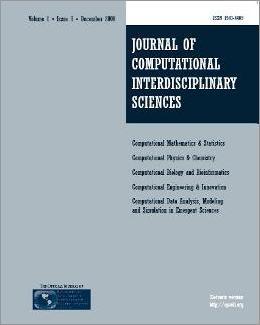
Editorial Office:
Management:
R. S. Oyarzabal
Technical Support:
D. H. Diaz
M. A. Gomez
W. Abrahão
G. Oliveira
Publisher by Knobook Pub


Editorial Office:
Management:
R. S. Oyarzabal
Technical Support:
D. H. Diaz
M. A. Gomez
W. Abrahão
G. Oliveira
Publisher by Knobook Pub
doi: 10.6062/jcis.2011.02.02.0037(Free PDF)
F.C. de Meneses, E.H. Shiguemori, P. Muralikrishna and B.R. Clemesha
ABSTRACT The inverse problem to retrieve useful airglow volume emission rate profiles from rocket-borne photometer measurements has been solved by adopting the well-characterized spectral photometric methods. An alternative recovery method based on artificial neural network (ANN) is presented. A multilayer perceptron neural network was trained with available experimental and synthetic data. Integrated emissions profiles measured by a rocket experiment were taken as the input data. From the results obtained in this work, it may be concluded that the ANN technique is a convenient tool to recover volume emission rate profiles.
applied computing in space and environmental sciences, neural networks, inverse problem, airglow, rocket.
[1] HARGREAVES JK. 1992. The Solar-Terrestrial environment, Cambridge University Press.
[2] GOMBOSI TI. 2004. Physics of the space environment, Cambridge University Press.
[3] CHAMBERLAIN JW. 1961. Physics of the Aurora and Airglow, Academic Press.
[4] HAIDER SA, KIM J, NAGY AF, KELLER CN, VERIGIN MI, GRINGAUZ KI, SHUTTE NM, SZEGO K & KIRALY P. 1992. Calculated ionization rates, ion densities, and airglow emission rates due to precipitating electrons in the nightside ionosphere of Mars. Journal of Geophysical Research, 97: 10637-10641.
[5] SLANGER TG, COSBY PC, HUESTIS DL & BIDA TA. 2001. Discovery of the Atomic Oxygen Green Line in the Venus Night Airglow. Science 291, 5503: 463-465.
[6] KRASNOPOLSKY VA. 1986. Oxygen emissions in the night airglow of the Earth, Venus and Mars. Planetary and Space Science, 34(6): 511-518.
[7] BURITI RA, TAKAHASHI H & GOBBI D. 2001. First results from mesospheric airglow observations at 7.5?S. Revista Brasileira de Geofísica, 19(2): 169-176.
[8] RAJESH PK, LIU JY, SINHA HSS, BANERJEE SB, MISRA RN, DUTT N & DADHANIA MB. 2007. Observations of plasma depletions in 557.7-nm images over Kavalur. Journal of Geophysical Research, 112: A07307.
[9] GOBBI D, TAKAHASHI H, CLEMESHA BR & BATISTA PP. 1992. Equatorial atomic oxygen profiles derived from rocket observations of OI 557.7 nm airglow emission. Planetary and Space Science, 40: 775-781.
[10] MELO STELLA ML, TAKAHASHI H, CLEMESHA BR, BATISTA PP & SIMONICH DM. 1996. Atomic oxygen concentrations from rocket airglow observations in the equatorial region. Journal of Atmospheric and Terrestrial Physics, 58(16): 1935-1942.
[11] GAO H, XU J & YUAN W. 2005. A Method of Inversing the Peak Density of Atomic Oxygen Vertical Distribution in the MLT Region From the OI (557.7nm) Night Airglow Intensity. Chinese Journal of Space Science, 25: 5.
[12] SHEPHERD G. 2002. Spectral imaging of the atmosphere, Academic Press.
[13] TAKAHASHI H, CLEMESHA BR, SIMONICH DM, MELO STELLA ML, ERAS A, STEGMAN J & WITT G. 1996. Equatorial airglow rocket measurement: MULTIFOT 92 data base. Journal of Atmospheric and Terrestrial Physics, 58(16): 1943-1961.
[14] MURTAGH DP, GREER RGH, McDADE IC, LLEWELLYN EJ & BANTLE M. 1984. Representative volume emission profiles from rocket photometer data. Annales Geophysicae, 2: 467-474.
[15] SISKIND DE & SHARP WE. 1991. A comparison of measurements of the oxygen nightglow and atomic oxygen in the lower thermosphere. Planetary and Space Science, 39(4): 627-639.
[16] CLEMESHA BR & TAKAHASHI H. 1996. Rocket-borne measurements of horizontal structure in the OH(8,3) and Na D airglow emissions. Advances in Space Research, 17(11): 81-84.
[17] ALTINAY O, TULUNAY E, TULUNAY Y. 1997. Forecasting of ionospheric frequency using neural networks. Geophysical Research Letters, 24: 1467-1470.
[18] WINTOFT P & CANDER LJR. 1999. Short-term prediction of fof2 using time-delay neural network. Physics and Chemistry of the Earth, Part C: Solar, Terrestrial & Planetary Science, 24(4): 343- 347.
[19] McKINNELL LA & POOLE WV. 2000. The development of a neural network based short term foF2 forecast program. Physics and Chemistry of the Earth, Part C: Solar, Terrestrial & Planetary Science, 25(4): 287-290.
[20] ZENG Z, HU X & ZHANG X. 2002. Applying artificial neural network to the short-term prediction of electron density structure using GPS occultation data. Geophysical Research Letters, 29(9): 35-1.
[21] NAKAMURA MI, MARUYAMA T & SHIDAMA Y. 2007. Using a neural network to make operational forecasts of ionospheric variations and storms at Kokubunji, Japan. Earth, Planets and Space, 59: 1231-1239.
[22] McKINNELL LA. 2002. A neural network based ionospheric model for the bottomside electron density profile over Grahamstown, South Africa, PhD. Thesis, Rhodes University, Grahamstown.
[23] McKINNELL LA & FRIEDRICH M. 2007. A neural network-based ionospheric model for the auroral zone. Journal of Atmospheric and Solar-Terrestrial Physics, 69(12): 1459-1470.
[24] VANDEGRIFF J, WAGSTAFF K, HO G & PLAUGER J. 2005. Forecasting space weather: Predicting interplanetary shocks using neural networks. Advances in Space Research, 36: 2323-2327.
[25] JANKOVIČOVÁ, D.; DOLINSKÝ, P.; VALACH, F.; VÖRÖS, Z. 2002. Neural network-based nonlinear prediction of magnetic storms. Journal of Atmospheric and Solar-Terrestrial Physics, 64(5-6): 651-656.
[26] OZC ELIK R, DIAMANTOPOULOU MJ, BROOKS JR & WIANT HV Jr. 2010. Estimating tree bole volume using artificial neural network models for four species in Turkey. Journal of environmental management, 91(3): 742-53.
[27] YANG Y, TAI NL & YU WY. 2005. ART artificial neural networks based adaptive phase selector. Electric Power Systems Research, 76: 115-120.
[28] ZHANG GP. 2010. Avoiding pitfalls in neural network research. IEEE Transaction on Systems, Man, and Cybernetics-Part C: Applications and Reviews, 37 i1. 3-16.
[29] SHIGUEMORI EH, CHIWIACOWSKY LD, DE CAMPOS VELHO HF & DA SILVA JDS. 2005. An inverse vibration problem solved by an artificial neural network. TEMA: Tendências em Matemática Aplicada e Computacional, 6(1): 163-175.
[30] HAYKIN, S. 1999. Neural Networks: A Comprehensive Foundation. Prentice Hall.
[31] JIMENEZ C, ERIKSSON P, MURTAGH D. 2003. First inversions of observed submillimeter limb sounding radiances by neural networks. Journal of Geophysical Research, 108(D24): 4791.